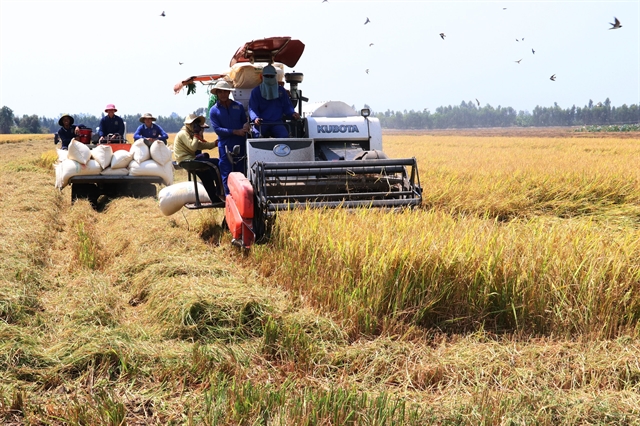 Society
Society

More rice farmers in the Cửu Long (Mekong) Delta province of Đồng Tháp have switched to growing high-quality rice varieties, which sell well and offer high profits.

|
| Harvesting rice in Đồng Tháp Province. – VNA/VNS Photo Nguyễn Văn Trí |
ĐỒNG THÁP – More rice farmers in the Cửu Long (Mekong) Delta province of Đồng Tháp have switched to growing high-quality rice varieties, which sell well and offer high profits.
More than 60 per cent of rice planted in Đồng Tháp are high-quality rice varieties, up 4.2 per cent against two years ago, according to the province Department of Agriculture and Rural Development.
These rice varieties include Jasmine 85, Nàng Hoa 9, OM 4900, OM 6976, Đài Thơm 8 and DTM 126.
The province, which is one of the delta’s largest rice producers, grows more than 520,000ha of rice a year with an annual output of 3.3 million tonnes.
Nguyễn Văn Phúc, who owns a 2ha rice field in Tháp Mười District’s Phú Điền Commune, said he switched from growing low-quality IR 50404 rice to the high quality Đài Thơ 8 rice in the 2019 - 20 winter – spring rice crop.
He harvested a yield of 8 tonnes of paddy per hectare in the 2019 -20 winter – spring rice crop, up 1 tonnes against the 2018 - 19 winter – spring rice crop.
He sold Đài Thơ 8 rice for VNĐ1,000 more than normal rice varieties.
Farmers and co-operatives that grow high-quality rice varieties have signed farm contracts with rice companies to guarantee outlets and stable prices.
The Thuận Tiến Agriculture Services Co-operative in Cao Lãnh District’s Gáo Giồng Commune has signed farm contracts with companies to produce high-quality rice.
According to Nguyễn Thanh Hùng, chairman of the Thuận Tiến, the co-operative’s high-quality rice is guaranteed an outlet with a price of VNĐ150 – 200 a kilogramme higher than the market price.
The co-operative members earn a profit that is 15 – 20 per cent higher than before and have stable outlets.
About 46 per cent of the province’s rice growing areas have been guaranteed outlets by rice companies.
To supply high-quality rice varieties for farmers, the province has conducted research and planted several new high-quality rice varieties suited to its soil and weather conditions.
Lê Ngọc Hoa of the Đồng Tháp High-Tech Agriculture Application Centre said the province had planted on a pilot basis two new varieties – RD71 and AD61 – in Hồng Ngự and Tân Hồng districts.
The two rice varieties are high quality, have a short maturity period, and yield 6 -7 tonnes per hectare.
Hồng Ngự and Tân Hồng districts are also expanding the cultivation of other high-quality rice varieties like OM 221 and OM 124 as they have a high yield of seven tonnes per hectare.
In the ongoing 2020 -21 winter – spring rice crop, the province targets growing about 200,000ha, focusing on high-quality varieties that meet market demand and are resistant to disease, according to the province’s Plant Cultivation and Protection Sub-department.
Nguyễn Văn Mười, director of the Tân Thuận Agriculture Services Co-operative in Châu Thành District’s An Phú Thuận Commune, said: “For the 2020 - 21 winter-spring rice crop, the co-operative decided to grow rice varieties that have high quality and high yield to increase profit for its members.”
Restructuring
Đồng Tháp authorities in recent years have encouraged farmers to turn ineffective rice fields to other high-value crops like fruit and aquaculture.
The average profit of fruits is about VNĐ370 million (US$16,000) per hectare a year, 3 - 8 times higher than profits from rice cultivation, according to farmers.
Trần Văn Nam in Tháp Mười District’s Thanh Mỹ Commune has switched from rice to growing lime on his 1.3ha rice field. He now earns a profit of VNĐ400 million ($17,300) per hectare a year.
More rice farmers have also rotated the cultivation of rice in the rainy season and other short - term crops like sesame in the dry season to save irrigation water and prevent the spread of rice diseases.
Rice farmers in the province have converted more than 16,240 ha of rice fields to high-value crops like fruit, vegetables, flower and ornamental plants and aquaculture, according to the province’s Department of Agriculture and Rural Development.– VNS




